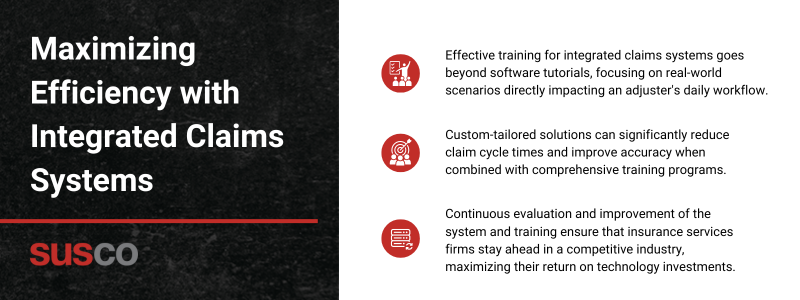
Adjusting firms face a unique challenge: leveraging technology to enhance efficiency without sacrificing the human touch that clients value. As claims volumes grow and the demand for quick resolutions increases, many firms find themselves stuck choosing between ill-fitting off-the-shelf solutions and the overwhelming task of developing custom software.
This is where the intersection of integrated systems and adjuster training becomes crucial. Modern claims management isn’t just about having the right tools; it’s about empowering your team to use them effectively. But what does “effectively” mean in an industry where every claim is unique and every client has different needs?
At Susco, we’ve spent years partnering with insurance adjusting firms to answer this question. Our experience has shown that the most successful firms don’t just adopt new technology – they adapt it to their specific workflows and train their adjusters to maximize its potential.
In this post, we’ll explore how integrated systems reshape claims management and why proper training is the key to unlocking their full potential. We’ll dive into the critical components of these systems, from real-time data access to process automation, and discuss how, when used correctly, they can dramatically improve efficiency and accuracy.
We’ll examine why a one-size-fits-all approach often falls short and how customized solutions tailored to your firm’s unique needs can make all the difference.
Whether you’re considering enhancing your existing claims management system or replacing an outdated or ill-fitting solution, this guide will provide valuable insights into preparing your team for success.
Understanding Integrated Systems in Claims Management
Integrated systems are revolutionizing claims processing and management. These systems integrate various aspects of the claims process into a cohesive platform, fundamentally changing how adjusters work and firms manage their resources.
At the heart of these systems is real-time data access, a game-changer that eliminates the delays associated with manual updates. Adjusters now have instant access to claim details, policyholder information, and historical data, enabling them to make informed decisions quickly without searching multiple databases or waiting for email responses.
Automation is another component, streamlining everything from initial claim intake to final settlement. Many routine tasks that once consumed adjusters’ time can now be handled automatically, including claim assignment based on expertise and workload, generation of standard correspondence, and even preliminary assessment of claim severity.
This automation frees adjusters to focus their expertise on complex cases and meaningful customer interactions, areas where human judgment and empathy are irreplaceable.
Enhanced communication and collaboration tools form the third pillar of these integrated systems. Features such as in-app messaging, document sharing, and collaborative workspaces ensure seamless communication between adjusters, claimants, and other stakeholders, keeping everyone aligned throughout the claims process.
These integrated systems are crucial for adjusters. They dramatically improve efficiency, allowing adjusters to handle more claims without sacrificing quality. Increased productivity benefits the firm and policyholders, leading to faster claim resolutions.
From a management perspective, integrated systems offer powerful tools for better resource allocation. Real-time dashboards showing adjuster workloads, claim statuses, and performance metrics allow for dynamic case assignment, ensuring that each claim receives the right level of attention.
Off-the-shelf solutions may offer many features, but their limitations can disrupt an adjusting firm’s unique workflows. That’s why custom software development is invaluable.
Components of an Effective Program
Implementing a new integrated claims management system is only half the battle. The true measure of success lies in how well your adjusters can leverage this technology to improve their work. A well-designed training program is crucial.
The foundation of any effective training program is a thorough needs assessment. This process involves more than just identifying what features the new system offers. It requires a deep dive into your adjusting team’s day-to-day operations.
By shadowing adjusters, conducting surveys, and analyzing current workflows, we can pinpoint exactly where the new system will have the most impact and where potential challenges might arise.
Move on to curriculum design. The key here is relevance. Generic software training won’t cut it. Instead, we develop content directly related to your adjusters’ daily tasks, including modules on efficiently navigating the new system while handling different types of claims or leveraging automated features to speed up routine processes without sacrificing accuracy.
Carefully crafted modules build skills progressively, allowing adjusters to immediately apply what they learn and see tangible improvements in their work.
A one-size-fits-all approach rarely succeeds when it comes to delivering this training. A blended learning strategy works best, including in-person workshops where adjusters can get hands-on experience with the new system under expert guidance.
This flexibility is crucial, especially for busy professionals juggling training with their regular workload.
Perhaps the most critical component of the training program is hands-on practice. There’s no substitute for learning by doing.
This allows adjusters to experiment, make mistakes, and learn in a risk-free setting. These practice sessions build confidence and help identify knowledge gaps before the system goes live.
Monitoring and Evaluating Training Effectiveness
Tracking the impact of your training program isn’t just about ticking boxes—it’s about ensuring your investment pays off in real-world performance. Here’s how we approach this critical phase:
- Measure knowledge retention through scenario-based assessments
- Track key metrics like claim processing times and accuracy rates
- Gather employee feedback on system usability and confidence levels
- Conduct pre- and post-training evaluations to quantify skill improvements
- Integrate performance data with regular employee reviews
- Analyze trends to identify high-impact training modules and potential gaps
- Update content based on emerging industry trends and user feedback
- Implement adjustments to the system itself based on user insights
Treating evaluation as an ongoing process rather than a one-time event ensures your claims management system and your team’s capabilities evolve in tandem, keeping you ahead in a competitive industry.
Custom CMS solutions from Susco
Susco is a leading technology solutions provider for forward-thinking IA companies. We build custom, human-centered software that unlocks efficiency and effectiveness throughout the claims cycle.
Book a free consultation now to learn more.